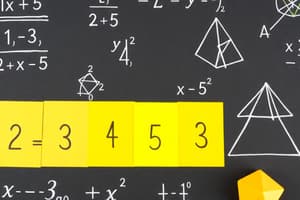Podcast
Questions and Answers
What is the formula for calculating the volume of a cylinder?
What is the formula for calculating the volume of a cylinder?
- 4/3 × π × radius³
- π × radius² × height (correct)
- side × side × side
- length × width × height
Which formula correctly calculates the surface area of a cube?
Which formula correctly calculates the surface area of a cube?
- 4 × π × radius²
- π × radius² × height
- 2 × (length × width + length × height + width × height)
- 6 × side² (correct)
To ensure accurate results when applying mensuration formulas, what must be consistent?
To ensure accurate results when applying mensuration formulas, what must be consistent?
- The units of measurement (correct)
- The shapes used in the formulas
- The volume of the figures
- The surface area calculations
What is the formula for the volume of a sphere?
What is the formula for the volume of a sphere?
In mensuration, which of the following is NOT a common unit of measurement for area?
In mensuration, which of the following is NOT a common unit of measurement for area?
What is the correct formula for calculating the area of a triangle?
What is the correct formula for calculating the area of a triangle?
Which of the following formulas represents the perimeter of a rectangle?
Which of the following formulas represents the perimeter of a rectangle?
What does mensuration primarily focus on in geometry?
What does mensuration primarily focus on in geometry?
How is the area of a circle determined?
How is the area of a circle determined?
Which formula calculates the surface area of a cube?
Which formula calculates the surface area of a cube?
In mensuration, which measurement is used to describe the total space occupied by a three-dimensional object?
In mensuration, which measurement is used to describe the total space occupied by a three-dimensional object?
What is the formula used to calculate the perimeter of a square?
What is the formula used to calculate the perimeter of a square?
Which dimensional quantity does area measure?
Which dimensional quantity does area measure?
Flashcards
Cube Volume Formula
Cube Volume Formula
Volume of a cube is calculated by multiplying the side length by itself three times.
Rectangular Prism Volume
Rectangular Prism Volume
Volume is found by multiplying length, width, and height.
Cylinder Volume
Cylinder Volume
Volume of a cylinder is calculated using pi, radius squared, and height.
Surface Area
Surface Area
Signup and view all the flashcards
Units in Mensuration
Units in Mensuration
Signup and view all the flashcards
Discrete Quantity
Discrete Quantity
Signup and view all the flashcards
Continuous Quantity
Continuous Quantity
Signup and view all the flashcards
Area
Area
Signup and view all the flashcards
Square Area
Square Area
Signup and view all the flashcards
Perimeter
Perimeter
Signup and view all the flashcards
Volume
Volume
Signup and view all the flashcards
Arithmetic Operations
Arithmetic Operations
Signup and view all the flashcards
Geometry
Geometry
Signup and view all the flashcards
Study Notes
Introduction to Math
- Mathematics is a broad field encompassing various branches and concepts.
- It deals with quantities, structures, spaces, and change.
- Fundamental branches include arithmetic, algebra, geometry, calculus, and more.
Types of Quantities
- Quantities can be categorized as discrete or continuous.
- Discrete quantities are countable, such as the number of students in a class.
- Continuous quantities can take on any value within a given range, like temperature or length.
Fundamental Operations
- Arithmetic operations include addition, subtraction, multiplication, and division.
- These form the basis for many mathematical concepts and applications.
- Order of operations (PEMDAS/BODMAS) is crucial for evaluating expressions correctly.
Geometry
- Geometry deals with shapes, sizes, and positions of figures in space.
- Fundamental shapes include points, lines, angles, triangles, quadrilaterals, circles, etc.
- Geometric concepts are used in many fields, including architecture, engineering, and computer graphics.
Mensuration
- Mensuration is the branch of geometry dealing with measurements of two-dimensional and three-dimensional shapes.
- Key components include calculating areas, perimeters, volumes, and surface areas.
- Different formulas apply depending on the shape.
Area
- Area is the measure of the two-dimensional space occupied by a plane figure.
- Formulae exist for calculating the areas of various shapes, including squares, rectangles, triangles, circles, parallelograms, and trapeziums.
- Examples include:
- Square: Area = side × side
- Rectangle: Area = length × width
- Triangle: Area = ½ × base × height
- Circle: Area = π × radius²
Perimeter
- Perimeter is the total length of the boundary of a two-dimensional shape.
- Calculates the distance around the shape.
- Formulas for perimeters vary depending on the shape.
- Square: Perimeter = 4 × side
- Rectangle: Perimeter = 2 × (length + width)
- Circle: Perimeter (circumference) = 2 × π × radius
Volume
- Volume measures the amount of space occupied by a three-dimensional object.
- Calculated in cubic units (e.g., cubic meters, cubic centimeters).
- Formulae vary based on the shape:
- Cube: Volume = side × side × side
- Rectangular prism: Volume = length × width × height
- Cylinder: Volume = π × radius² × height
- Sphere: Volume = (4/3) × π × radius³
Surface Area
- Surface area is the total area of all the faces of a three-dimensional object.
- Calculated in square units (e.g., square meters, square centimeters).
- Different surface area formulas apply for various shapes.
- Cube: Surface area = 6 × side²
- Rectangular prism: Surface area = 2 × (length × width + length × height + width × height)
- Cylinder: Surface area = 2 × π × radius × (radius + height)
- Sphere: Surface area = 4 × π × radius²
Units of Measurement
- Different units are used to measure length, area, volume, and other quantities.
- Important to use consistent units when applying formulas.
- Common units include meters, centimeters, millimeters, kilometers, square meters, cubic meters etc.
Applications of Mensuration
- Mensuration finds extensive applications in various fields.
- Architects and engineers use it to design buildings, bridges, and other structures.
- It’s crucial in calculating areas of land to determine property value.
- Used in industrial design.
Studying That Suits You
Use AI to generate personalized quizzes and flashcards to suit your learning preferences.




